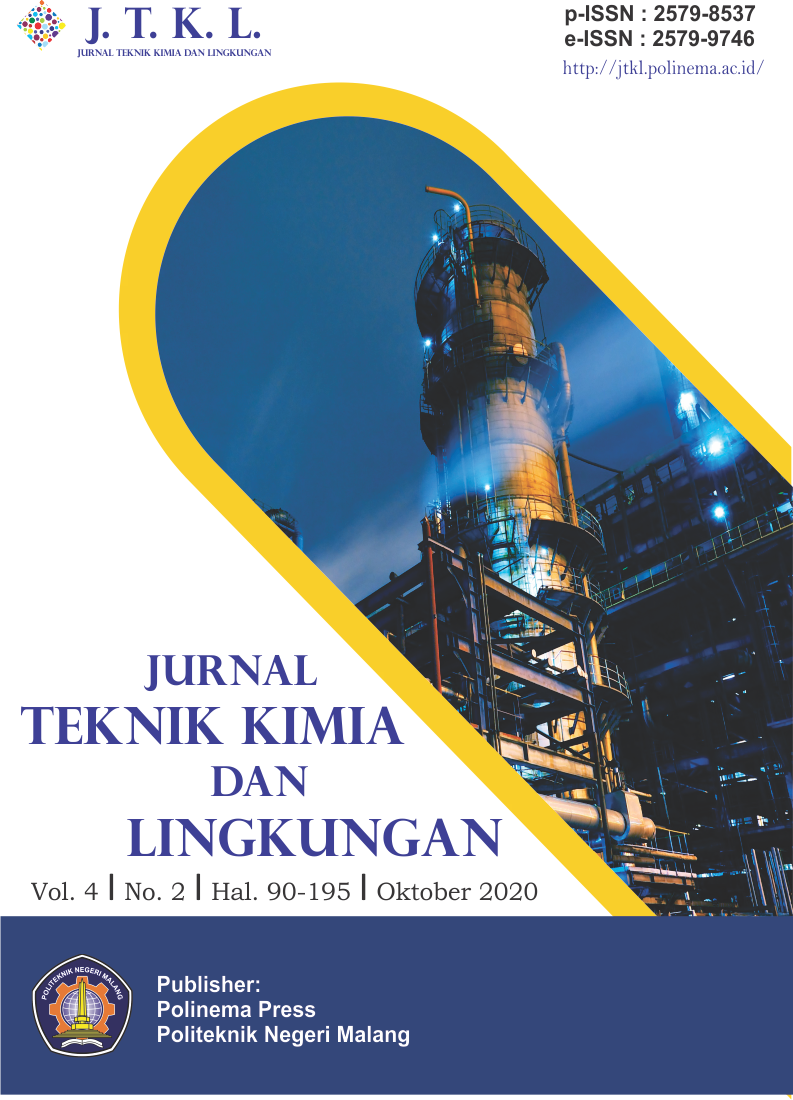Optimasi Penambahan Gliserol sebagai Plasticizer pada Sintesis Plastik Biodegradable dari Limbah Nata de Coco dengan Metode Inversi Fasa
DOI:
https://doi.org/10.33795/jtkl.v4i2.140Keywords:
biodegradable plastic, glycerol, nata de coco waste, phase inversion methodAbstract
Limbah nata de coco merupakan nata yang tidak dapat dijadikan sebagai produk setelah proses sortasi sehingga menghasilkan limbah padat dan jarang dimanfaatkan. Kandungan selulosa pada limbah padat nata de coco sebesar 42,57%. Tujuan penelitian ini membuat plastik biodegradable dengan hasil limbah nata de coco dengan penambahan plasticizer. Metode yang digunakan pada pembuatan plastik biodegradable ini adalah metode inversi fasa dengan variasi berat selulosa 2%; 2,5%; dan 3% (b/v), variasi volume gliserol sebesar 2%, 3%, dan 5% (v/v), dan penambahan kitosan sebagai penguat. Karakteristik pastik biodegradable diuji menggunakan UTM (Universal Testing Machine) dan FTIR (Fourier-Transform Infrared Spectroscopy). Plastik biodegradable yang dihasilkan dari berbagai perbandingan berat selulosa dan volume gliserol memiliki karakteristik yang berbeda-beda. Plastik biodegradable dengan karakteristik optimal memiliki nilai kuat tarik optimal sebesar 4,34 MPa, nilai elongasi optimal sebesar 4,44% dan nilai ketahanan air optimal sebesar 65,20%. Pada analisis gugus fungsi menggunakan FTIR menunjukkan tidak ditemukan adanya gugus fungsi baru dalam plastik biodegradable selain gugus fungsi bahan pembentuknya. Pada uji biodegradabilitas, diperoleh nilai biodegradabilitas sebesar 80% – 100% setelah ditimbun di dalam tanah selama 14 hari.
Nata de coco waste is nata that cannot be used as a product after the sorting process so that it produces solid waste and is rarely utilized. The cellulose content in nata de coco solid waste is 42.57%, the purpose of this study is to make biodegradable plastic with the results of nata de coco waste by adding plasticizers. The method used in the manufacture of biodegradable plastics is the phase inversion method with cellulose weight variation; 2%; 2.5%; and 3% (w / v), variations in the volume of glycerol by 2%, 3%, and 5% (v/v), and the addition of chitosan as an amplifier. The biodegradable plastic characteristics were tested using UTM (Universal Testing Machine) and FTIR (Fourier-Transform Infrared Spectroscopy). Biodegradable plastics that are produced from various weight cellulose and glycerol volume ratios have different characteristics. Biodegradable plastic with optimal characteristics has an optimal tensile strength value of 4.34 MPa, optimal elongation value of 4.44% and an optimal water resistance value of 65.20%. In the analysis of functional groups (FTIR) no new functional groups were found in biodegradable plastics in addition to the functional groups forming materials. In the biodegradability test, a biodegradability value of 80% - 100% is obtained after being buried in the ground for 14 days.
References
A. Septiosari, Latifah, dan E. Kusumastuti, Pembuatan dan Karakterisasi Bioplastik Limbah Biji Mangga dengan Penambahan Selulosa dan Gliserol, Indonesian Journal of Chemical Science, vol. 3, no. 2, hal. 157–162, 2014.
S. Aripin, B. Saing, E. Kustiyah, Studi Pembuatan Bahan Alternatif Plastik Biodegradable dari Pati Ubi Jalar dengan Plasticizer Gliserol dengan Metode Melt Intercalation, J. Tek. Mesin, vol. 06, no. 2, hal. 79–84, 2017.
D. P. Dewanti, Potensi Selulosa dari Limbah Tandan Kosong Kelapa Sawit untuk Bahan Baku Bioplastik Ramah Lingkungan, Teknol. Lingkung., vol. 19, no. 1, hal. 81–88, 2018.
S. Puspitasari, Pemanfaatan Limbah Padat Nata de Coco untuk Produksi Bioetanol menggunakan Zymomonas mobilis, Skripsi, Departemen Teknologi Industri Pertanian, Institut Pertanian Bogor, Indonesia, 2014.
I. G. Sanjaya M.H and T. Puspita, Pengaruh Penambahan Khitosan dan Plasticizer Gliserol pada Karakteristik Plastik Biodegradable dari Pati Limbah Kulit Singkong, Undergraduate Paper, Jurusan Teknik Kimia FTI, Institut Teknologi Sepuluh November, Indonesia, 2012.
P. Coniwanti, L. Laila, dan M. R. Alfira, Pembuatan Film Plastik Biodegredabel dari Pati Jagung dengan Penambahan Kitosan dan Pemplastis Gliserol, J. Tek. Kim., vol. 20, no. 4, hal. 22–30, 2014.
U. Andriayani, Harlia, I. Syahbanu, Pembuatan Polyblend dari Limbah Styrofoam dan α-Selulosa Serat Daun Nanas sebagai Bahan Dasar Plastik Ramah Lingkungan, J. Kim. Khatuliswa, vol. 7, no. 3, hal. 40–46, 2018.
M. Yuspitasari, I. Syahbanu, dan P. Ardiningsih, Studi Waktu Penguapan pada Pembuatan Blend Membran Polisulfon/Selulosa Asetat dari Nata de Coco, J. Kim. Khatuliswa, vol. 7, no. 4, hal. 16–24, 2018.
Inayati, D. J. Pamungkas, dan M. Matovanni, Effect of Glycerol Concentration on Mechanical Characteristics of Biodegradable Plastic from Rice Straw Cellulose, AIP Conf. Proc., vol. 030110, no. April, hal. 030110-1–7, 2019.
W. N. R. Jami’an, H. Hasbullah, F. Mohamed, W. N. Wan Salleh, N. Ibrahim, R. R. Ali, Biodegradable Gas Separation Membrane Preparation by Manipulation of Casting Parameters, Chem. Eng. Trans., vol. 43, hal. 1105–1110, 2015.
A. Sofia, A. T. Prasetya, dan E. Kusumastuti, Komparasi Bioplastik Kulit Labu Kuning-Kitosan dengan Plasticizer dari Berbagai Variasi Sumber Gliserol, Indones. J. Chem. Sci., vol. 6, no. 2, hal. 111–116, 2017.
I. Nafiyanto, Pembuatan Plastik Biodegradable dari Limbah Bonggol Pisang Kepok dengan Plasticizer Gliserol dari Minyak Jelantah dan Komposit Kitosan dari Limbah Cangkang Bekicot (Achatina fullica), Integr. Lab J., vol. 07, no. 1, hal. 75–89, 2019.
I. Wardah dan E. Hastuti, Pengaruh Variasi Komposisi Gliserol dengan Pati dari Bonggol Pisang, Tongkol Jagung, dan Enceng Gondok Terhadap Sifat Fisis dan Mekanis Plastik Biodegradable, J. Neutrino, vol. 7, no. 2, hal. 77–85, 2015.
L. Nurdini, Hendriyana, H. Fansyuri, dan T. Wibowo, Pengaruh Penambhan Pati Ubi kayu dalam Pembuatan Bioplastik dari Pati Sukun, Pros. Semin. Nas. Tek. Kim. "Kejuangan", Yogyakarta, April 2018, hal. K8-1–5.
A. B. Dias, C. M. O. Müller, F. Larotonda, dan J. B. Laurindo, Biodegradable Films Based on Rice Starch and Rice Flour, Journal of Cereal Science, vol. 51, no. 2 hal. 213–219, 2010.
Downloads
Published
Issue
Section
License
Copyright (c) 2020 Claudia Candra Setyaningrum, Kholisoh Hayati, Siti Fatimah

This work is licensed under a Creative Commons Attribution-NonCommercial 4.0 International License.







